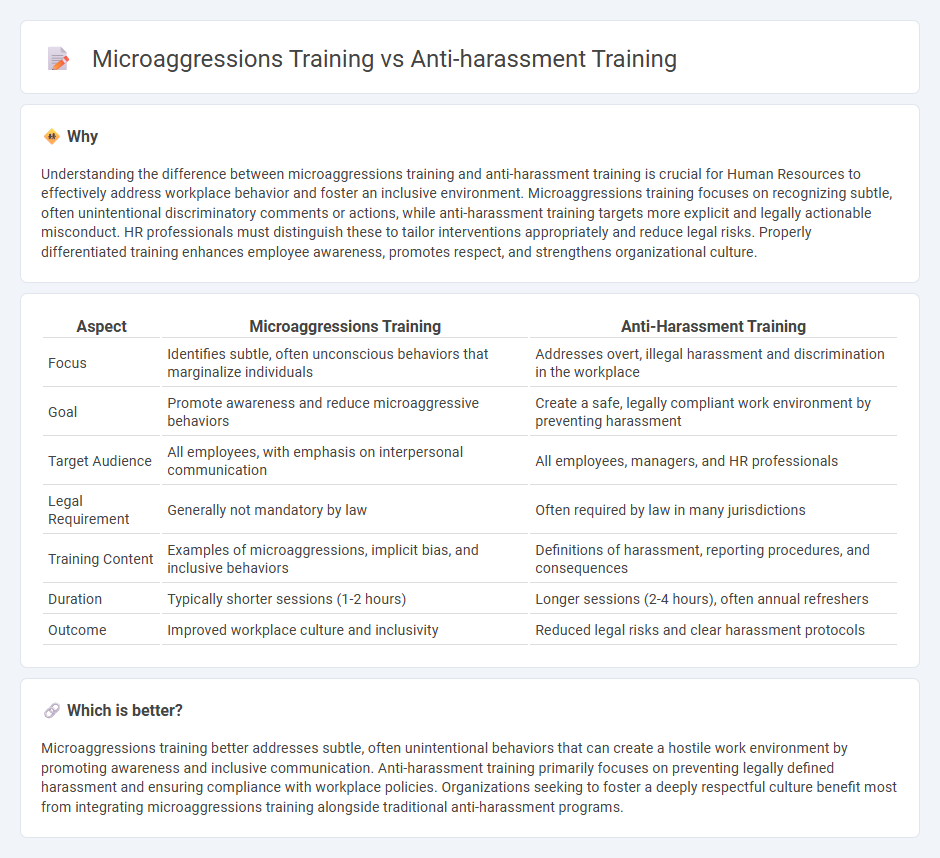
Microaggressions training focuses on identifying and addressing subtle, often unintentional behaviors that create a hostile workplace environment, while anti-harassment training targets explicit actions and policies that prevent legally defined harassment. Both trainings aim to foster respectful communication and inclusivity but differ in scope and approach to improving workplace culture. Discover how these distinct programs can enhance employee relations and compliance in your organization.
Why it is important
Understanding the difference between microaggressions training and anti-harassment training is crucial for Human Resources to effectively address workplace behavior and foster an inclusive environment. Microaggressions training focuses on recognizing subtle, often unintentional discriminatory comments or actions, while anti-harassment training targets more explicit and legally actionable misconduct. HR professionals must distinguish these to tailor interventions appropriately and reduce legal risks. Properly differentiated training enhances employee awareness, promotes respect, and strengthens organizational culture.
Comparison Table
| Aspect | Microaggressions Training | Anti-Harassment Training |
|---|---|---|
| Focus | Identifies subtle, often unconscious behaviors that marginalize individuals | Addresses overt, illegal harassment and discrimination in the workplace |
| Goal | Promote awareness and reduce microaggressive behaviors | Create a safe, legally compliant work environment by preventing harassment |
| Target Audience | All employees, with emphasis on interpersonal communication | All employees, managers, and HR professionals |
| Legal Requirement | Generally not mandatory by law | Often required by law in many jurisdictions |
| Training Content | Examples of microaggressions, implicit bias, and inclusive behaviors | Definitions of harassment, reporting procedures, and consequences |
| Duration | Typically shorter sessions (1-2 hours) | Longer sessions (2-4 hours), often annual refreshers |
| Outcome | Improved workplace culture and inclusivity | Reduced legal risks and clear harassment protocols |
Which is better?
Microaggressions training better addresses subtle, often unintentional behaviors that can create a hostile work environment by promoting awareness and inclusive communication. Anti-harassment training primarily focuses on preventing legally defined harassment and ensuring compliance with workplace policies. Organizations seeking to foster a deeply respectful culture benefit most from integrating microaggressions training alongside traditional anti-harassment programs.
Connection
Microaggressions training and anti-harassment training are interconnected as both address subtle and overt behaviors that create a hostile work environment, promoting respect and inclusivity. Microaggressions training focuses on identifying and mitigating unconscious biases and subtle discriminatory acts, while anti-harassment training targets clear violations of workplace conduct policies. Together, they form a comprehensive strategy to foster a safe, respectful, and equitable workplace culture in human resources management.
Key Terms
Anti-harassment training:
Anti-harassment training targets the prevention of unlawful behaviors such as sexual harassment, discrimination, and hostile work environments by educating employees on recognizing, reporting, and responding to inappropriate conduct. This training often includes legal definitions, company policies, and strategies to promote respectful workplace culture. Discover more about how anti-harassment training can transform your organizational environment and compliance efforts.
Hostile Work Environment
Anti-harassment training addresses overt behaviors and legal definitions related to creating a hostile work environment, emphasizing clear policies and consequences for discrimination and harassment. Microaggressions training targets subtle, often unintentional actions or comments that contribute to workplace hostility by undermining inclusivity and employee well-being. Explore comprehensive strategies to cultivate a respectful and supportive work culture.
Quid Pro Quo
Anti-harassment training primarily addresses unlawful behaviors like Quid Pro Quo harassment, where job benefits are conditioned on sexual favors, establishing clear legal boundaries and workplace policies. Microaggressions training concentrates on subtle, often unintentional discriminatory comments or actions that create a hostile work environment but may not always meet the legal definition of harassment. Explore further to understand how these trainings complement each other in fostering a respectful and inclusive workplace culture.
Source and External Links
Online Workplace Harassment Training for Employees - EVERFI - Offers interactive, scenario-based training covering discrimination, bias, microaggressions, hostile environments, retaliation, and provides managers with intervention and reporting tools, while also clarifying state-specific mandates.
Sexual Harassment Prevention Training Course - Traliant - Delivers continuously updated, legally compliant courses with real-life interviews and cinematic scenarios, addressing sexual harassment, bullying, bystander intervention, reporting, retaliation, and discrimination prevention for all 50 states.
Workplace Harassment Training - NAVEX - Provides industry-leading, customizable training on harassment terminology, prevention, response, digital harassment, diversity, equity, inclusion, discrimination, and power dynamics, aligned with current U.S. legislation.
 dowidth.com
dowidth.com